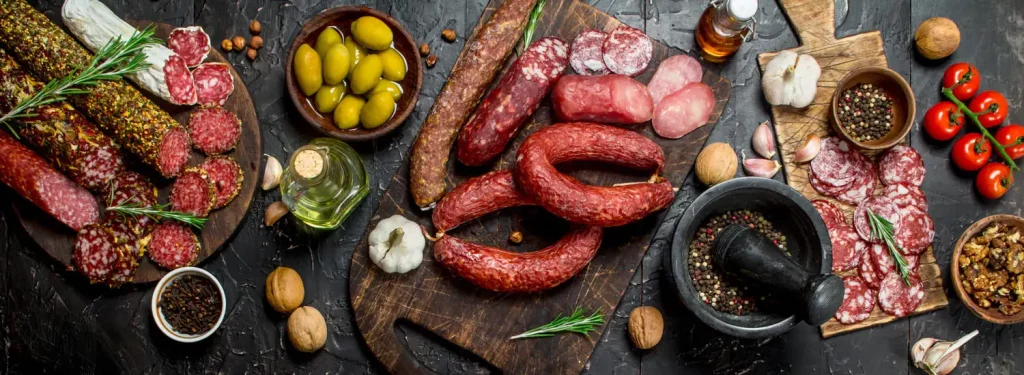In Spain, there is a wide variety of sausages, each with its own tradition and method of production. Below, we talk about some of the most common sausages in Spain:
- Chorizo: it is one of the best known sausages in Spain. It is made with minced pork meat marinated with paprika and other spices. There are many varieties of chorizo, including spicy and sweet chorizo. At César Nieto we have the Acorn-fed Iberian Chorizo and the 100% natural Iberian Chorizo.
- Salchichón: is another popular sausage made with minced pork meat marinated with salt and pepper. Unlike chorizo, it does not contain paprika. Sausage usually has a softer and more delicate texture than chorizo. You can enjoy it in our store: Acorn-fed Iberian Salchichón and 100% natural Iberian Salchichón .
- Lomo embuchado: it is made with marinated and cured pork loin. It is a lean and dry sausage that can be consumed as an appetizer or in sandwiches. At César Nieto we have a wide variety of Iberian pork loins: 100% Iberian acorn-fed pork loin, 50% Iberian acorn-fed pork loin, 50% Iberian Cebo pork loin and 50% Iberian natural pork loin.
- Morcilla: a sausage made with pork blood and other ingredients such as onion, rice and spices. There are many varieties of morcilla in Spain, including morcilla de Burgos and morcilla de arroz.
- Butifarra: a typical Catalan sausage made with minced pork and spices. There are many varieties of butifarra, including white butifarra and black butifarra.
- Fuet: it is a dry and fine sausage made with minced, marinated and fermented pork meat. It is very popular in Catalonia.
- Sobrasada: it is a typical sausage of the Balearic Islands that is made with pork, paprika and other ingredients. It has a smooth texture and can be consumed either hot or cold.
- Cecina: a sausage made from cured beef. It is cut into thin slices and consumed cold as an appetizer or in sandwiches.
- Morcón: It is made with pork meat, especially the lean part and the fat, and is seasoned with garlic, paprika, salt and other spices. Sometimes white wine or cognac is also added to give it a more intense flavor. The morcón is cured for several weeks, which gives it a characteristic flavor and aroma. It is usually consumed in thin slices as an appetizer or as an ingredient in different dishes of Spanish cuisine. Morcón is typical of the regions of Castilla y León, Extremadura and Andalusia in Spain.
These are just a few examples of the most common sausages in Spain, but there are many other regional varieties that are equally delicious and popular.
In addition to the most common sausages, there are other lesser-known but equally delicious varieties typical of some regions of Spain. The following are some examples:
- Botillo: a typical sausage from the region of El Bierzo, in the province of León. It is made with pork meat, ribs, ear, tail, tongue and bones, all marinated with salt, paprika and other ingredients. It is usually cooked and served in slices.
- Longaniza: it is a typical sausage from the area of Catalonia, Aragon and the Valencian Community. It is made with minced pork, marinated and stuffed in casings. It can be dried or fresh and is usually consumed in sandwiches or cooked.
- Chireta: a typical sausage from Aragón and Navarra that is made with lamb tripe stuffed with lamb meat, rice, onion and spices. It is usually cooked in the oven or grilled.
- Zorza: a typical Galician sausage made with minced pork meat marinated with paprika, garlic and other spices. It is usually consumed grilled or in stews.
- Llonganissa: a typical Catalan sausage made with minced pork meat marinated with salt, pepper and other spices. It is usually eaten in sandwiches or grilled.
- Txistorra: is a typical sausage from the Basque Country and Navarre that is made with minced pork and marinated with paprika, garlic and other ingredients. It has a soft texture and can be eaten in sandwiches or grilled.
These are just a few examples of the less common sausages in Spain, but there are many other regional varieties that are equally delicious and worth trying.
